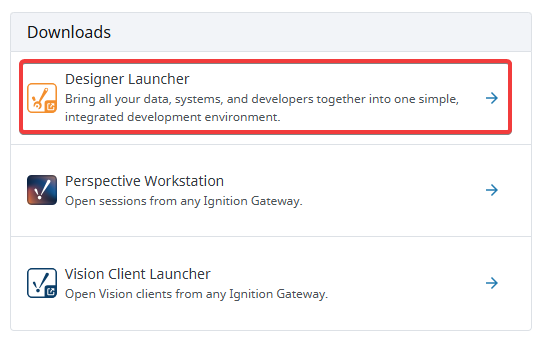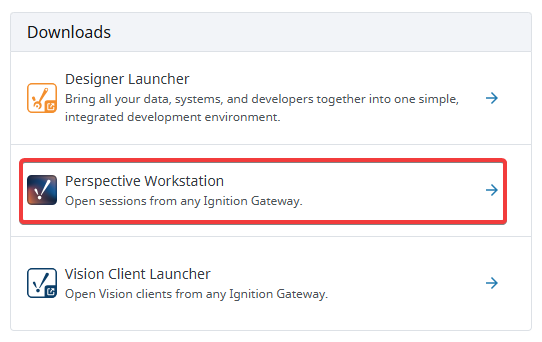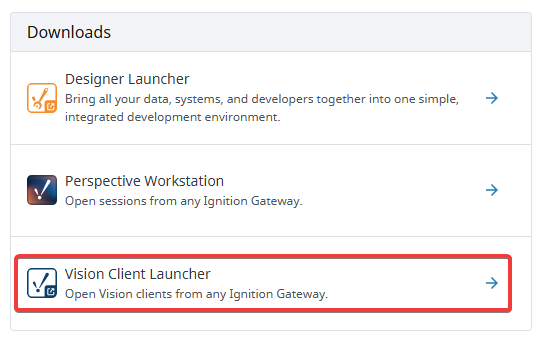Gateway
The Ignition Gateway is the primary software service that drives everything in Ignition. It is a single application that runs as a web server and is accessed through a web browser. Its capabilities include connecting to data and PLCs, executing modules, and communicating with clients. You can customize the home page to fit your needs using the Gateway settings. From the Gateway, you can perform actions such as activating Ignition, transferring licenses, backing up and restoring the Ignition Gateway, and setting up redundancy. You can even set up a Gateway Network that allows two or more Gateways to connect to one another and share data.
Accessing the Gateway
The Gateway is accessed through a web browser (via the Gateway Web Interface). The web browser, running on any machine, must have network access to the host that is running the Gateway.
Any other computer on the same network can access the Gateway Webpage by using the IP address or host name of the computer where Ignition is installed, followed by the port Ignition is using. By default, Ignition installs by using the 8088 port.
For example, if the host's IP address is 10.0.28.30, you can access the Gateway via the URL: http://10.0.28.30:8088. Additionally, when Ignition is installed on the computer that you are logged into, you can access the Gateway Webpage by typing http://localhost:8088, instead of your machine's IP address or host name.
Gateway Web Interface (Gateway Webpage)
The Gateway Web Interface performs a variety of functions and drives everything in Ignition. You can set up your licensing and activation, and configure your Gateway settings, databases, devices, projects, modules, security, and alarming. It also provides access to the OpenAPI documentation, which lists available HTTP API endpoints for external integration.
Designer Launcher
The Designer Launcher locates all the Gateways that are available on your local network. Once the Designer is open, you can access existing projects or create new projects on the Gateway. The Designer Launcher button on the right side of the Welcome page on the Home tab opens the Designer Launcher Download page.

Alternatively, you can go to the Home tab and click on Designer > Download.
Here, you can find all the Designer Launchers for each operating system: Windows, Mac and Linux. Ignition automatically detects your operating system so all you have to do is download the launcher and follow the steps to install the Designer Launcher.

To learn about what the Designer can do, go to the Designer section of this manual.
Perspective Workstation
The Perspective Workstation allows you to run Perspective applications originating from any Gateway your network has access to. You can use the Perspective Workstation button on the right side of the Welcome page on the Home tab to open the Perspective Workstation Download page.

Alternatively, you can go to the Home tab and click on Perspective > Download.
Here, you can find all the Perspective Workstations for each operating system: Windows, Mac and Linux. Ignition automatically detects your operating system so all you have to do is download Perspective Workstation and follow the steps to install it.

Using the Launch page, you can also directly launch your Perspective applications from the Gateway.
To learn about Perspective, go to the Perspective section of this manual.
Vision Client Launcher
The Vision Client Launcher allows you to run Vision projects originating from any Gateway your network has access to. You can use the Vision Client Launcher button on the right side of the Welcome page on the Home tab to open the Vision Client Launcher Download page.

Alternatively, you can go to the Home tab and click on Vision > Download.
Here, you can find all the Vision Client Launchers for each operating system: Windows, Mac and Linux. Ignition automatically detects your operating system so all you have to do is download the Vision Client Launcher and follow the steps to install it.

Using the Launch page, you can also directly launch your Vision projects from the Gateway.
To learn about Vision, go to the Vision section of this manual.
Starting and Stopping the Gateway
After installation, the Gateway starts automatically. The Gateway runs as a service, so you can use your operating system's normal mechanisms to start or stop the service. You can also start or stop the Gateway from command line.
Windows
Ignition's installation directory contains start-ignition.bat and stop-ignition.bat, which can start or stop the service.
For example:
C:\Program Files\Inductive Automation\Ignition> start-ignition.bat
However, you can also use Windows native service commands to control the running state of the Gateway:
net start ignition
net stop ignition
Linux
You can control the service using the ignition.sh script. It can be called with the start and stop parameters to perform the relevant operations.
For example:
/usr/local/bin/ignition/ignition.sh start
Additionally, you can use native terminal commands to start or stop the service:
service Ignition-Gateway start
service Ignition-Gateway stop
MacOS
You can access the service from the install directory using the "ignition.sh" script. On a typical Mac install using the dmg installer, the full command (without a custom location specified) is the following:
/usr/local/ignition/ignition.sh start
Gateway Command-line Utility
The Gateway Command-line Utility - gwcmd (GCU) is a lightweight standalone application that provides information about the Gateway. It performs high-level tasks such as stopping and restarting the Gateway server, and setting ports used between the Gateway and clients. It shows the status of the Tomcat web server and the Ignition Gateway application. You can reset the Gateway password, and even launch the web browser to the Gateway Webpage.
For more information, refer to the page on the Gateway Command-line Utility - gwcmd.
Gateway Architecture
The Gateway’s architecture contains many parts, each one letting you perform a specific task. Some of these parts include:
- System Management
- Project and Module Management
- Security and Auditing Settings
- Database Connectivity
- Alarming and Modification Settings
- Tags Provider Settings
- OPC Connectivity
- Enterprise Administration Settings
- Projects
The following image shows the different parts of the Gateway and how projects work within the Gateway. Note the parts that are outside the Ignition Gateway box, such as non-Ignition OPC servers, databases, and devices, are all separate from Ignition but can be connected.

